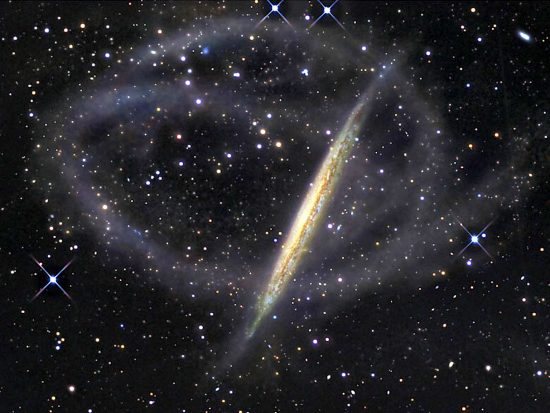
April 2, 2020
Stellar streams are known to plasma physicists as Birkeland currents.
Birkeland current filaments at every scale thread through the Universe. There are loads in those circuits converting electrical energy into rotation: they are called, “galaxies”.
Galactic evolution, contrary to the gravity-only theories from consensus astronomy, takes place because of large-scale plasma discharges that form them. Stars in galaxies tend to coalesce like bright beads on string; a puzzling alignment, according to astrophysicists. The barred spirals and elliptical whirlpools that congregate in million-light-year clusters also continue to elude explanation. Enigmatic structures, like the multiple strands of material extending outward from NGC 5907, enclose them in loose cocoons.
In an Electric Universe, filaments of electric charge follow closed circuits through plasma that attract matter to them over vast distances. Double layers glow in visible or infrared light. However, plasma might also initiate dark discharges. Perhaps those are the “dark lanes” seen by astronomers in many galaxies. Some spiral arms exhibit dark, twisted strands of material.
Those filaments are composed of “ionized hydrogen”, or electric charge carriers. The hydrogen atom is built from one electron and one proton, so ionization reduces it to individual nucleons. Since electricity is generated by charged particles in motion, the filaments are transmitting electromagnetic energy across vast distances. What holds these “transmission lines” together?
Since the hydrogen in NGC 5907 is ionized, it is defined as a plasma. In an Electric Universe, charge flow in plasma generates electromagnetic fields that constrict the current channel. Previous Pictures of the Day point out that the constriction is known as a “Bennett pinch,” or “z-pinch.” Pinched electric filaments remain coherent over long distances because they wind around each other without coalescing, something like a twisted pair of electric wires.
It is well-known that Birkeland currents are probably the greatest long-range attractors in the Universe, with a force more about 39 orders of magnitude greater than gravity. Birkeland currents attract each other when they are far apart, but repel each other when they are close, resulting in pairs of filaments spiraling around their common axes.
Electric fields in such galaxy-sized currents accelerate charge carriers to near light speed. An electric field’s strength near an electrically charged object is defined as inversely proportional to the distance between the point and the object. However, according to retired Professor of Electrical Engineering, Dr. Donald Scott, the electric field between Birkeland currents in space falls off with the square root of the distance, increasing the attractive force.
Filaments, “star streams” and loose cocoons are manifestations of electricity in space.
Stephen Smith
The Thunderbolts Picture of the Day is generously supported by the Mainwaring Archive Foundation.












